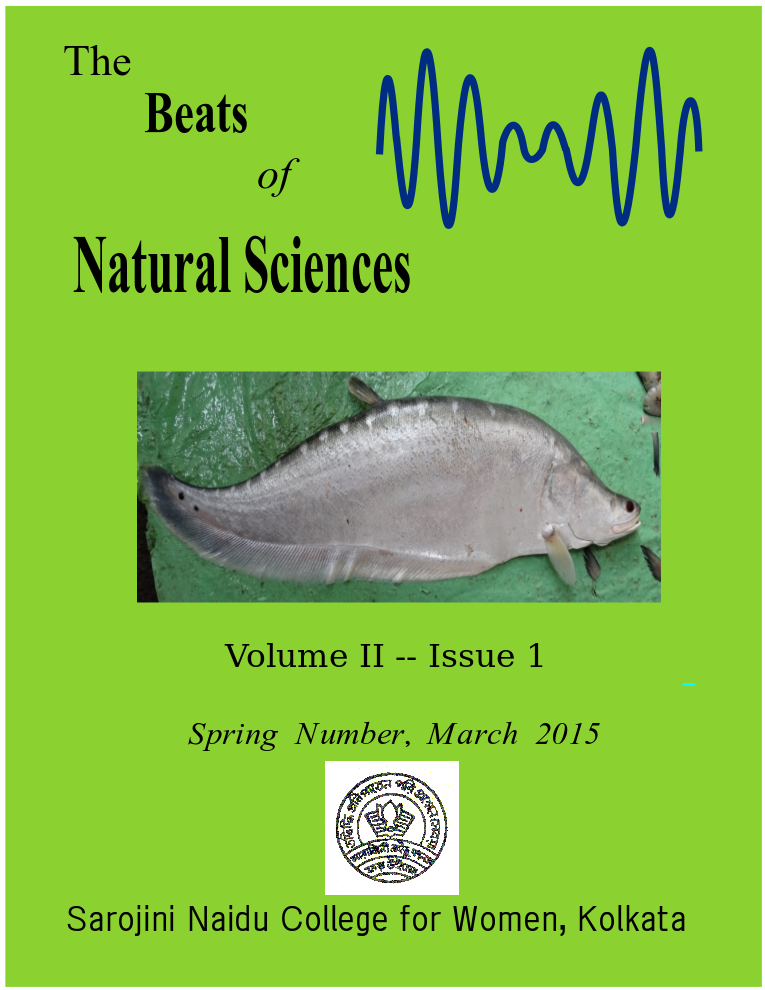ISSN 2348 – 7615
Volume II, Issue 1
Spring Number (March), 2015
From the Desk of the Editors:
This journal now steps into its second annual volume. Though we are striving for maintaining the production quality of this journal at a certain standard, due to absence of any dedicated editorial staff it is becoming increasingly difficult. The bibliographic index of the first volume has not yet been ready, but it will be published shortly. But the source of our strength is the support we are getting from the numerous contributors and well wishers of this journal. In every month we are receiving a number of submission in varying fields of science which we try to accommodate. Though we do not have a formal peer review system, for each submission we try to gather opinion of the researcher/ academician working in the related fields. Then before acceptance we usually do a technical check from the perspective of the final production. In this process the contributors are often communicated for any change if we feel necessary. The support and enthusiasm we are getting in the whole process from all who are concerned is quite inspiring. But being a journal published by a college and managed only by its faculty members, side by side their teaching and other academic loads, ‘The Beats’ is still suffering form some obvious shortfalls. But …
Download pdf: From the Desk of the Editors
Brief reports of original research works:
- Role of disorder in the two-site Holstein model with double exchange
Jayita Chatterjee [dropdown_box expand_text=”Abstract” show_more=”View” show_less=”Hide” start=”hide”]Using the perturbation method based on a variational phonon basis obtained by the modified Lang-Firsov (MLF) transformation, the two-site double-exchange Holstein model is studied in presence of a finite difference in bare site energies (\epsilon_d=\epsilon_2-\epsilon_1). The polaronic ground-state wave function is calculated up to the fifth order of perturbation. The effect of \epsilon_d (acts as a site-energy disorder) on the polaron crossover, polaronic kinetic energy and polaron localization are studied. Role of disorder on the properties of the double-exchange system is
discussed.[/dropdown_box] Download Full Paper
- Empowerment of parents of children diagnosed with Autism Spectrum Disorder (ASD) through parent training and intervention program
Mitu De, Vandana Kumar, Naureen Huda, Ranjana Chakrabarty and Indrani Basu [dropdown_box expand_text=”Abstract” show_more=”View” show_less=”Hide” start=”hide”]Parents are an untapped resource when it comes to their children’s educational, social, and health development. Past research show that parental involvement is linked to greater developmental outcomes in children with a diagnosis of Autism Spectrum Disorder (ASD). Parents are now recognized for the key roles they can play in ongoing child training and skill generalization. Autism Society West Bengal (ASWB), Kolkata, India, a parent initiated, not for profit organization promoting the support and inclusion of individuals with Autism spectrum disorders (ASD) in the society, runs three-month parent- child training and intervention program, designed to provide parents with basic facts about individu als with autism spectrum disorders (ASD) and strategies for working with these individuals utilizing collaborative partnerships. Once trained, partici pants themselves became trainers for their child at home. The major aim of the program was to promote family empowerment through parent–professional collaboration. The objective of this study was to explore the changes in the parental perceptions following parent training and intervention program for children newly diagnosed with Autism Spectrum Disorder (ASD) and the subsequent empowerment. [/dropdown_box] Download Full Paper
- Status of Predatory Ichthyofauna Diversity of Malda and Murshidabad District of West Bengal: An Approach towards Biodiversity Management
Jhilik Das, Meghna Saha and Santi Ranjan Dey [dropdown_box expand_text=”Abstract” show_more=”View” show_less=”Hide” start=”hide”]Fish diversity depends upon many physical parameters of aquatic environment. West Bengal is a State that has all types of representative edaphic diversity of India. The river Ganga and its tributaries flow through Murshidabad and Malda districts. These are the transitional districts because the soil type of the North Bengal is vastly different from that of South Bengal. North Bengal has lateritic and South Bengal has clayey soil type. Predatory Ichthyofauna is very important in ecosystem because they maintain balance. As they are less abundant because they are top most carnivores, they are the most effected part due to anthropogenic activities like organized fisheries. The present study is an attempt to assess the abundance of Predatory Ichthyofaunal diversity in these two adjacent districts. Database on fish biodiversity is essential as a decision making tool for conservation and management of fish germplasm, protection and preservation of endangered species and mitigation of anthropogenic activities so as to fulfill India’s obligations under Convention on Biological Diversity. The present work will serve as a documentation of the predatory ichthyofauna of Malda and Murshidabad district which may be utilized for future fish biodiversity management of the two districts. [/dropdown_box] Download Full Paper
Review on current frontiers or historical milestones:
- A Review on Organometallic M(I)–M(I) Single Bonded Chemistry of Group 2 and 12 Metals
Surajit Jana [dropdown_box expand_text=”Abstract” show_more=”View” show_less=”Hide” start=”hide”]In recent times, complexes containing metal-metal single bonds are one of the synthetic challenging areas of chemistry. The interest also stems from several perspective including synthetic methodology, structure, reactivity, and theoretical involvement. Compared to group 12, 13 and 14 metals, the alkaline earth metals (group 2) is still its infancy. However, recent years have witnessed major achievements of organo-alkaline earth compounds for catalytic utilization. These include hydroamination, hydrophosphination, hydrosilylation, hydrogenation, and polymerization reactions. After the most important breakthrough of the organometallic low-valent stable Zn(I) –Zn(I) compound by Carmona and co-workers, this field of research gets new direction. Hg(I) –Hg(I) compounds are known from 14th century. But, the organometallic Cd(I)–Cd(I) and Hg(I)–Hg(I) complexes are reported recently. In 2007, Jones and co-workers were successful in isolating a group 2 metal Mg(I) dimer containing a Mg–Mg single bond. But, till date there is not a single Ca(I) dimer reported. This review article provides some information about such type of complexes and there various applications. [/dropdown_box]Download Full Paper
- Enchanting Islands : Insular Biology Revisited
Supatra Sen[dropdown_box expand_text=”Abstract” show_more=”View” show_less=”Hide” start=”hide”] Islands represent small, isolated “microcosms” with discrete boundaries, they vary greatly in size, age, isolation, shoreline structure, topography and geology. Due to their isolation from more widespread continental species, islands are ideal places for unique species to evolve. Island biogeography is the study of the distribution and dynamics of species of island environments. In species diversity, Island Biogeography not only highlights allopatric speciation (new gene pools arising out of natural selection in isolated gene pools) but also considers sympatric speciation (different species arising from one ancestral species). Thus islands house unique species – relics of the old – the survivors and the products of evolution – the new species. The Island Biogeography Theory – aptly termed the ‘First Law of Conservation Biology’ applied to habitat fragments spurred the development of the fields of conservation biology and landscape ecology. [/dropdown_box]Download Full Paper
- A Review on Applications & Advantages of Cryopreservation in Different Fields of Science
Shrabani Barun[dropdown_box expand_text=”Abstract” show_more=”View” show_less=”Hide” start=”hide”] Cryopreservation is a practical application of cryobiology which is the study of biological material or system at temperature below normal. It is a process where cells, whole tissues or any other substances susceptible to damage caused by chemical reactivity or time are preserved by cooling to sub-zero temperature. It’s goal is to replace some of the water with other compound like DMSO & glycerol. It is applied in different fields of science like fishery science, medical science, micro biology & many other fields. Most importantly now-a-days it is used in fertility treatment and storage of biological specimens either for future or simply as a record of biodiversity. It is the only technique that ensures the safe and cost-efficient long-term conservation of various types of plants. [/dropdown_box]Download Full Paper
Contact Informations :
| Publisher: Principal, SAROJINI NAIDU COLLEGE FOR WOMEN |
Address: SAROJINI NAIDU COLLEGE FOR WOMEN,30, Jessore Road, Dumdum, Kolkata 700028, India | Phone No.: +91-33-2559 2583 email: info@sncwgs.ac.in |
| Editors: Dr. Sonali Saha Dr.Soma Aditya Bandyopadhyay Dr. Chaitali Biswas |
Address: SAROJINI NAIDU COLLEGE FOR WOMEN,30, Jessore Road, Dumdum, Kolkata 700028, India | Phone No.: +91-33-2559 2583 email:editors.bns@sncwgs.ac.in |
 Pay Your Fees
Pay Your Fees 



